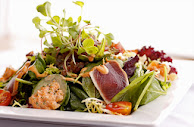Donald, what have you done?
It wasn't enough for you to seduce me with Cochon's
Wood-Fired Oyster Roast and
Fried Oyster and Bacon Sandwich during my visit to New Orleans last year. But then, you had to send me home with an autographed copy of your cookbook,
Real Cajun: Rustic Home Cooking from Donald Link's Louisiana, so I could recreate these delicacies at home.
I did recreate
those, and more. Need I remind you of your grown-up version of
Chocolate Yummy, with its rich pecan shortbread crust, topped with cream cheese, a silky layer of dark chocolate pudding, and fresh whipped cream, just another one of your creations that melted my heart? I think not.
Since Mardi Gras is just around the corner, and we're miles apart, I sought comfort in pulling out my cherished
Rustic Cajun to bring back those fond memories of our time together in New Orleans. I'm sure you know what I'm about to say; I can tell by that smirk on your face. Yes, I've fallen in love all over again - this time with your
Old-School Chicken and Sausage Jambalaya.
Please take that smirk off your face. Besh isn't going to be happy when he finds out I choose your jambalaya over his
gumbo!
I didn't realize there are two types of jambalaya - Cajun and Creole, but I was drawn in when you explained how you prefer the Cajun type because it's simpler and more rustic. Funny, that's
my style. Simple, rustic and elegant! When you described how the chicken and sausage flavor blend into the rice, creating a dish with a robust meaty flavor, I was in my car and off to the store within minutes, distracted by thoughts of satisfying country cooking clouding my head. I choose the most beautiful vegetables I could find, a plump free-range chicken, some tasty Cajun andouille sausage, and a few more spices.
While my chicken roasted, I chopped vegetables and made the homemade spice blend, taking in all the aroma and warmth filling the kitchen. It's wonderful using the roasted chicken carcass and vegetable trimmings to make the broth, but I was truly swooned with your method of developing layers of flavor with each step, by searing and caramelizing the sausage and onions in order to develop color and deeply browned flavors, and adding and reducing small amounts of chicken broth to achieve
the MSG effect, as you call it
(that unique saltiness that you just can't achieve by adding salt).
Although I'm devastated I didn't make it to New Orleans this year, to spend another delectable and leisurely afternoon at Cochon's bar, eating oysters, alligator bites, gumbo, and Louisiana cochon, and sipping Moonshine with Tyler, you were definitely in my thoughts as I savored each incredible bite of your Jambalaya, two nights in a row. Oh Donald, my Donald.
Old-School Chicken and Sausage Jambalaya
Real Cajun: Rustic Home Cooking from Donald Link's Louisiana
Serves 6-8
Ingredients:
1 chicken (3 1/2- to 4-pound), roasted
2 medium onions, 1 quartered, 1 diced small
1 tablespoon canola oil
1 pound smoked sausage (such as andouille), diced
2 tablespoons butter
1 green bell pepper, cored, seeded, and diced
1 red bell pepper, cored, seeded, and diced
2 small jalapeño peppers, seeded and minced
1 bunch scallions (white and light green parts), thinly sliced
3 celery stalks, diced
4 garlic cloves, minced
1 tablespoon
Donnie’s Spice Mix (recipe below)
2 teaspoons salt
5 bay leaves
2 teaspoons dried oregano
2 tablespoons tomato paste
2 1/2 cups long-grain rice, rinsed
Preparation:
1.
Roast the chicken: Preheat oven to 350 degrees F. Rinse the chicken in cold water and pat dry with paper towels. Place the chicken in a roasting pan, rub with olive oil, and season with salt and pepper. Place the chicken in the oven and roast for 35 minutes. Turn the heat up to 425 degrees F and roast for another 10-15 minutes. Remove the chicken from the oven, transfer to a plate, cover with foil, and let it rest for 15-20 minutes to allow the juices to settle. When cool enough to handle, pick all the meat from the chicken (discard skin) and use your hands to shred it into pieces. Save all the juice and fat from the roasting pan and plate and set aside. Refrigerate chicken until needed.
2.
Prepare the vegetables: While the chicken is roasting, cut and dice all the vegetables and reserve the vegetable trimmings to go in the stock pot when you prepare the chicken broth.
3.
Make the chicken stock: Place the carcass, quartered onion, and vegetable trimmings into a large pot. Add 10 cups of water, bring to a boil, reduce heat, and simmer for about 1 hour. Strain the broth, and discard solids. You should have about 6 cups.
4. While the broth is simmering, prepare
Donnie's Spice Mix (recipe below) and dice the sausage.
5.
Final Preparation of the Jambalaya: Heat the oil in a medium cast-iron skillet over medium-high heat, and add the sausage. Sear until the sausage starts to color. Parts of the sausage will begin to stick to the pan. When there is a good coating stuck to the pan, pour in 1/4 cup chicken broth, and scrape it loose. Let this cook until all the liquid has evaporated. Transfer the sausage to a plate, and set aside.
6. Return the pan to the heat, and add the butter. When it melts, add the diced onion, and cook about 10 minutes, until a nice deep brown color. About halfway through, the onion should start to stick to the pan; deglaze with 1/4 cup chicken broth, and let this reduce until the skillet is dry (or
au sec, as they say in French kitchens). When the onion starts to stick again, add 1/2 cup broth; when this is almost gone, add the bell peppers, jalapeños, scallions, celery, garlic, spice mix, salt, bay leaves, oregano, and tomato paste. Cook the vegetables for 10 minutes, stirring often, until they start to stick to the skillet. Deglaze with another 1/4 cup broth and reduce again until dry, then add the shredded chicken, 1 cup broth, and the juices from the chicken, and reduce again by half.
7. Transfer the vegetable mixture to a heavy-bottomed pot, and add the sausage, rice and the remaining 4 cups broth. You want this mixture to have plenty of room, so the rice will cook more evenly. Cook, covered, over low heat for 40 minutes.
8. Remove pot from the heat, and keep covered for 10 minutes more. If the rice seems unevenly cooked, leave this lid on a little longer, and it will even out. When jambalaya is done, transfer to a casserole dish so it does not overcook in the pan, and serve.
Donnie’s Spice Mix
2 tablespoons cayenne pepper
2 tablespoons paprika
1 tablespoon ground white pepper
1 tablespoon ground black pepper
4 tablespoons chili powder
1 tablespoon garlic powder
Combine all spices in a bowl, and store in airtight container.






























































